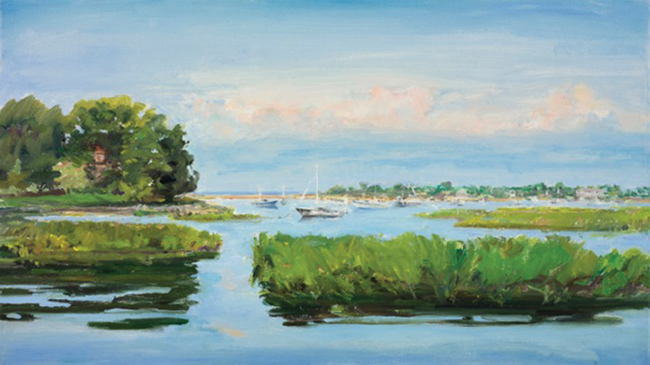
Mount Sinai Harbor on Long Island’s north shore, one of 50 Long Island Sound embayments being studied for the risk of eutrophication in a newly-funded research project.
Oil painting and photo by Joan Branca.
In spring of 2013, the Sea Grant programs of Connecticut and New York, with the US Environmental Protection Agency (EPA)’s Long Island Sound Study program, began funding research that will help efforts to improve water quality and adapt to climate change. The two projects, totaling $708,308 in funding, involve teams of researchers in three states, making it a truly collaborative effort.
In one of the two-year projects, researchers will estimate the risk of eutrophication for 50 embayments in the Long Island Sound region.
Jamie Vaudrey,
Charles Yarish and
Jang Kyun Kim from the University of Connecticut, and
Christopher Pickerell and
Lorne Brousseau from Cornell Cooperative Extension of Suffolk County, NY, will use computer models to calculate estimates for dissolved nitrogen concentrations and freshwater flushing times for each embayment. They will also sample each embayment at dawn and slack tide during the summer hypoxia season and compare the results with existing field data. An assessment of risk for each embayment, including potential impacts to food webs, will be prepared and distributed to coastal managers.
In another project, researchers will analyze historical trends back to the 1970s to project and manage Long Island Sound’s future. The research team will be led by
Nickitas Georgas of Stevens Institute of Technology. Working with
Alan Blumberg and
Philip Orton, the team will synthesize physical data collected for Long Island Sound and global climate change indices. The computer model will first model backward in time, a process called “hindcasting.” Results will be compared to historic marine resources data from the CT Department of Energy and Environmental Protection provided by
Penny Howell, and a high-resolution global climate model from
Vincent Saba of National Oceanic and Atmospheric Administration (NOAA)’s Geophysical Fluid Dynamics Laboratory in Princeton, NJ. Finally, the computer model will look forward to simulate the effects of climate on Long Island Sound’s physical environment and living marine resources up to the year 2100. This multi-disciplinary approach to projecting conditions in the Sound for the rest of the 21st century is of great interest to both stakeholders and regional managers as they pursue management strategies in response to climate change.
“Long Island Sound is continually changing due to human impacts and these studies will help document these changes and predict future ones, helping to improve management,” said
Jim Ammerman, former Director of New York Sea Grant at Stony Brook University.
“The information derived from these projects will be invaluable for managers dealing with critical issues affecting the health of the Sound,” said
Mark Tedesco, Director of EPA’s Long Island Sound Office in Stamford, CT, which manages the Long Island Sound Study.
“It is exciting to see researchers from different institutions leverage their knowledge and expertise into multidisciplinary projects that will provide new information to better understand and manage Long Island Sound,” said
Sylvain De Guise, Director of Connecticut Sea Grant at the University of Connecticut.
The Long Island Sound Study Research Grant Program is conducted by the two Sea Grant programs: New York Sea Grant, based at Stony Brook University on Long Island and Connecticut Sea Grant, based at the University of Connecticut at Avery Point. Both are part of the National Sea Grant College Program network, administered by NOAA. Funding for the program is provided to the Sea Grant programs by US EPA as part of the Long Island Sound Study, a cooperative effort between the EPA and the states of Connecticut and New York to restore and protect the Sound and its ecosystem.
—Barbara A. Branca